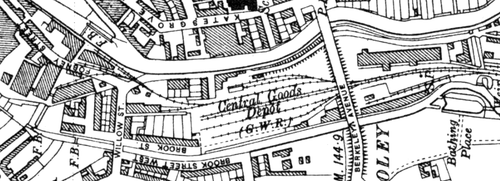Reading Central Goods railway station
Coordinates: 51°27′01″N 0°58′32″W / 51.4503°N 0.9755°W
| Central Goods | |
|---|---|
| Location | |
| Place | Reading |
| Area | Berkshire |
| Operations | |
| Original company | Great Western Railway |
| History | |
| 4 May 1908 | Opened |
| 20 March 1969 | Bear Wharf closed |
| 25 July 1983 | Closed |
| January 1985 | Rails and sleepers removed |
| Disused railway stations in the United Kingdom | |
|
Closed railway stations in Britain A B C D–F G H–J K–L M–O P–R S T–V W–Z | |
|
| |
Reading Central Goods was a goods-only railway station in Reading, Berkshire, England, connected to the Reading to Basingstoke Line by the Coley Branch Line. The station operated between 1908 and 1983.
History
The branch line and depot were authorised for construction by the Great Western Railway (Additional Powers) Act of 1905 to alleviate cartage as the result of Reading General station being situated to the north of the town.[1] The depot, built by Henry Lovatt of Wolverhampton on the site of a Masonic Temple,[1] opened in 1908 and was accessed from the Reading to Basingstoke Line along a single-track branch line on an embankment.[2]
Located between the River Kennet and the Holy Brook, the depot had 12 sidings—located in six pairs—with accommodation for approximately 300 wagons carrying goods such as coal, timber, brick, stone, hay, straw and fertiliser.[1][2] serving local businesses such as the Co-Operative's jam works, Anglo-American Oil, Gascoignes (manufacturers of dairy machinery and inventors of the Kee Klamp), Baynes's timber yard and Simonds Brewery.[2] At Bear Wharf, adjacent to County Lock on the Kennet, a siding was built to allow transition of goods transported by rail and barge, with locomotives sometimes being used to tow vessels short distances against the current.[1] With the decline of the river's use for goods transport the wharf closed in 1969.[2]
The depot and railway closed in 1983, with the track being removed two years later.[1] The trackbed approaching the depot was used as part of the route of the A33 road approach to Reading town centre, and the Berkeley Avenue (A4) bridge that formerly straddled the railway now allows road traffic to pass under.
